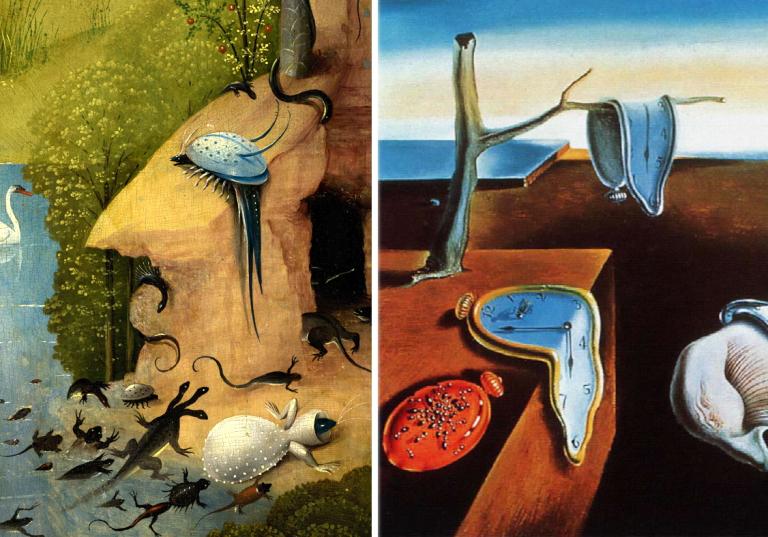
In the background, a hypnotic ocean view opens out across the horizon, acting as an enduring symbol for the dream-like states Dali invoked in his art.“The Persistence of Memory” is a famous oil on canvas painting which features a number of melting pocket watches.

But in typical Dali fashion, he brings in elements of the absurd by floating his still life objects in mid-air, and it is as if they are actually alive. We see a new aesthetic in this particular painting which is photorealist in style. During this time he entered a new artistic period which he called “Nuclear Mysticism,” merging elements of science, physics and art together. Living Still Life, 1956 Salvador Dali, Living Still Life, 1956, The Dali Museum, Floridaīy the time Dali painted Living Still Life, 1956, he had moved to Portlligat in Spain, where he remained for the rest of his life. The entire image is filled with disturbing references to the advent of war, expressing the artist’s growing sense of helplessness and despair. Haunting, unsettling imagery includes a female figure stretched like rubber over a dead tree, a spindly daddy longlegs, a melting violin, and a violent cannon shooting out a thick liquid alongside a majestic silver horse.

It signifies a new era in his art, with fresher colors and photographic qualities of light. Fascinated by its detail, Freud observed, “it would be very interesting to explore analytically the growth of a picture like this.”ĭaddy Longlegs of the Evening Hope, 1940 Salvador Dali, Daddy Longlegs of the Evening Hope, 1940, Dali Museum, Floridaĭali made Daddy Longlegs of the Evening Hope, 1940, shortly after moving to the United States, following the outbreak of World War II. Dali famously took this painting with him when he met his hero, the great psychoanalyst Sigmund Freud in 1938. Dali’s meticulously painted rendition of the story depicts a hunched Narcissus to the left, who gazes into a reflective pool, while on the right, a haunting white stone hand holds an egg from which the Narcissus flower emerges, signifying the process of rebirth and regeneration at the heart of the story. After falling in love with his own reflection in a pool, he drowned trying to grasp it, and was immortalized as the Narcissus flower. This painting was Dali’s interpretation of the Greek myth of Narcissus, the arrogant, youthful beauty who broke many hearts. Metamorphosis of Narcissus, 1937, is another profound example of Dali’s “paranoiac critical” period, when he was obsessed with painting an imaginary world dominated by irrationality and dreams. Metamorphosis of Narcissus, 1937 Salvador Dali, Metamorphosis of Narcissus, 1937, image courtesy of Tate Gallery, London In the center of the image, the amorphous head is based on Dali’s own profile, while in the background, the mountains mimic those of his homeland in Catalan. He argued, if the real world had led us into a horrifying world war, then escapism into another one was the only way out. In doing so, his intention was to let go of the rational, physical world and enter into a new one dominated by dreams and subconscious thought. At the time of making this painting Dali was developing what he called a “paranoiac-critical” method, which involved inducing psychotic episodes and hallucinations that would provide imagery for his art.

The Persistence of Memory, 1931 remains today Dali’s most iconic and celebrated works of art, and its signature melting clocks are now synonymous with his name. The Persistence of Memory, 1931 Salvador Dali, The Persistence of Memory, 1931, Museum of Modern Art, New York The self-contained boxes here reflect Dali’s growing fascination with cinema, and its ability to transport us outside the ordinary world – he made his first film Un Chien Andalou, (An Andalusian Dog), 1928-9, not long before completing this painting. Much like many of Dali’s paintings, the backdrop setting behind them is a barren desert, which became a potent symbol for the unconscious human mind. Three boxes dominate the canvas, each playing out their own stories inside. Illumined Pleasures, 1929, was made by Salvador Dali during his mature period, as he was finding his voice as a leading Surrealist painter in Paris. Illumined Pleasures, 1929 Salvador Dali, Illumined Pleasures, 1929, Museum of Modern Art, New York


 0 kommentar(er)
0 kommentar(er)
